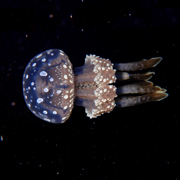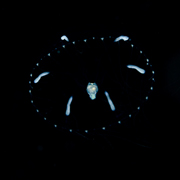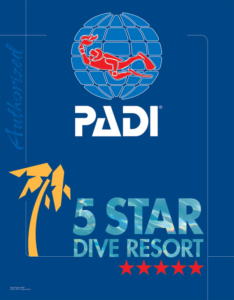Bonfire Dive; Diving in a primeval soup!
Bonfire Dives are amazing and a little bit eerie at the same time. I feel like I’m watching a video where it shows you all the microscopic organisms living in a petri dish in some mad scientist’s laboratory. Wormy things swirling around, clear tube-like animals propelled along with what looks like a mouth, small silver fish darting around, presumedly try to eat the wormy things, I have no idea what any of their real names are.
So, what exactly is a “Bonfire Dive”? It’s still a relatively new type of dive, where it originated from, I’m not exactly sure, the first time I heard about it was when a group of divers I was guiding had decided to do a “Black Water Dive” (more on this in our next bog) and we had to cancel due to bad weather. That was when one of the divers suggest we do a bonfire dive, which can be done in a sheltered bay, unlike the Black Water Dive which is done out in the open ocean.
 Any diver who enjoys night dives can do a Bonfire Dive, simple to organize and you don’t need any specialized equipment or training other than the usual for night diving. What you do need is as many underwater lights as you can get your hands on, the more powerful the better, and a big roll of duct tape comes in handy. Basically, you tape all the lights together making a “Mega Light” make sure you can still reach all the switches and you have a light for yourself, your buddy and any other divers that might be joining the dive.
Any diver who enjoys night dives can do a Bonfire Dive, simple to organize and you don’t need any specialized equipment or training other than the usual for night diving. What you do need is as many underwater lights as you can get your hands on, the more powerful the better, and a big roll of duct tape comes in handy. Basically, you tape all the lights together making a “Mega Light” make sure you can still reach all the switches and you have a light for yourself, your buddy and any other divers that might be joining the dive.
Now you’re ready for the dive, you need a dive site with a steep slope and not too much current, I’ve found sheltered bays facing out into deep water work well, jump in, head down to 30ft/10m and find a place to secure your “Mega light”. Makes sure it’s facing out into the deep water, its not going to fall over and of course it’s not on any sensitive marine life. If you haven’t figured it out yet this is where the dive gets its name from, as the lights resemble a bonfire.
The best thing about Bonfire dives, “it’s a two for one”, you need to let the lights do their job, so swim away and have fun making sure you can find your way back to the lights after around 30 minutes or so.
 Ok, so you have just enjoyed a 30-minute night dive and seen lots of amazing creatures, now it’s time to investigate that primeval soup and see what its cooked up. You can either be directly behind the lights, off to the side a little or sometimes it pays off to head out into the dark water on the edge of where the lights reach. The closer you are to the lights the more, swirly, whirly, wormy things there are, this can creep some divers out, it’s also much more difficult to get a clear shot of an individual critter.
Ok, so you have just enjoyed a 30-minute night dive and seen lots of amazing creatures, now it’s time to investigate that primeval soup and see what its cooked up. You can either be directly behind the lights, off to the side a little or sometimes it pays off to head out into the dark water on the edge of where the lights reach. The closer you are to the lights the more, swirly, whirly, wormy things there are, this can creep some divers out, it’s also much more difficult to get a clear shot of an individual critter.
Now I said I didn’t know the names of any critters, and that was true for the first few Bonfire dives I did, however I can tell you you’re likely to see lots of fire worms, zoo plankton, salps/tunicates and various amounts of shrimps. Some of the more elaborate critters that show up would be Mantis Shrimp Larvie, Paper Nautilus, juvenile octopus, and other unusual cephalopods.
In conclusion, Bonfire Dives are a very cool way to spice up your night dives and see some awesome critters that you would otherwise probably never get the chance to view. Their easy to organize, especially if you’re already set up for night diving and you don’t need to be super experienced. An excellent alternative to Black Water Dives.
Written by: Jamie Gladwin
Photo credits to: Rob de Vries & Thomas Preusse
Posted on: June 12, 2022
More blogs
More blogs on the website of Magic Oceans
– Coastal Cleanup
– The Significance of Mooring Buoys for Diving
– The Beauty of Muck Diving
– A Night to Remember – by Frogfish Photography
– Fascinating Jellyfish
– Meeting Shaun the Sheep – by Frogfish Photography
– Pagasidae
– Nudibranchs
– Blue Ringed Octopus
– Frogfish
– Bargibanti Pygmy Seahorses
– Bohol: gem of the Visayas
– Divetrip to Camiguin Island: Island born of Fire (I)
– Divetrip to Camiguin Island: Time for some action (II)
– Divetrip to Camiguin Island: Sunken Cemetery (III)
– Divetrip to Camiguin Island: Island Hopping (IV)
– Divetrip to Camiguin Island: Mantigue Island (V)
– Mystical Lamanok (I)
– Mystical Lamanok (II)
– Mystical Lamanok (III)
– Mystical Lamanok (IV)
– Mystical Lamanok (V)

















